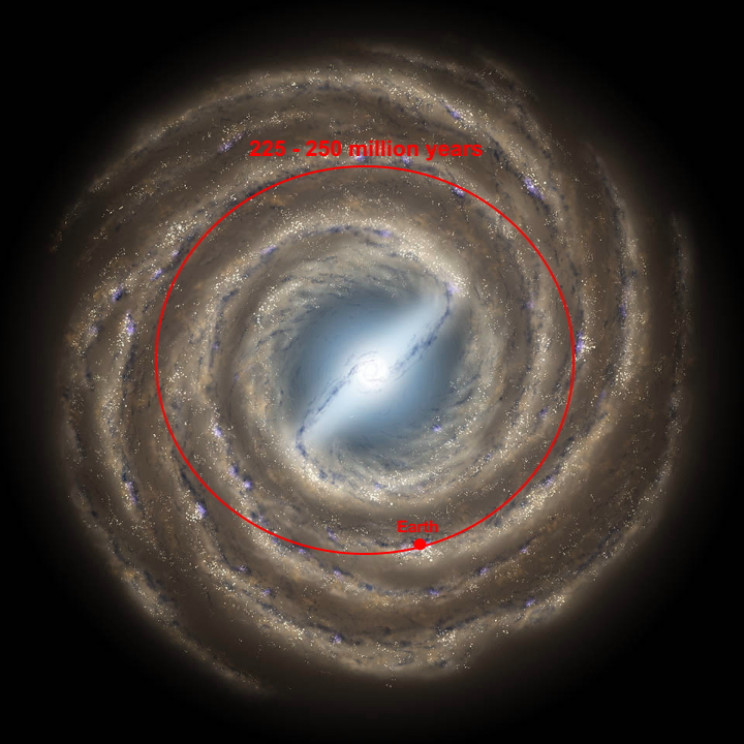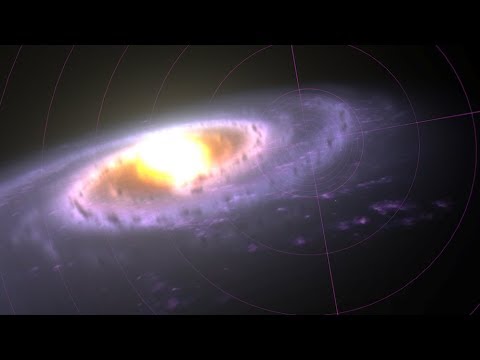Everyone knows that the Earth revolves around the Sun, taking one year to complete a full revolution. But, the Sun is also revolving around our Milky Way galaxy, and it takes it 225 to 250 million years to complete one revolution.
The Milky Way is a barred spiral galaxy having a diameter of around 150,000 to 200,000 light-years. It contains somewhere between 150 to 400 billion stars and an estimated 100 billion planets.

Our solar system is located at a distance of around 26,000 light-years from the galactic center, on the inner edge of what is called the Orion Arm.
The stars comprising the innermost 10,000 light-years from the galactic center form a bulge that extends vertically both above and below the galactic plane. At least one bar radiates from that bulge.
At the galactic center is an intense source of radio waves known as Sagittarius A*, because it appears within that constellation. At the center of the Milky Way, it is also theorized that there is a supermassive black hole weighing 4.1 million solar masses.
Stars, such as our Sun, orbit the galactic center at roughly 220 kilometers per second, but this speed implies that the Milky Way contains much more mass than is apparent. Roughly 95% of the mass of the Milky Way is invisible, neither emitting nor absorbing electromagnetic radiation. This is so-called " dark matter."
Since the Earth is estimated to be 4.543 billion years old, that means it has traveled around the Milky Way, along with the Sun, multiple times. Recently, NASA scientist Jessie Christiansen pointed out what was happening on Earth during our last revolution around the galaxy.
Same time last galactic year - the Jurassic Period
The last time we were at the same point around the galaxy as we are now, the Jurassic Period was just beginning on Earth. It lasted approximately 56 million years, starting at the end of the Triassic Period, around 201.3 million years ago, and ending at the beginning of the Cretaceous Period, about 145.5 million years ago.
The Jurassic Period is named after the Jura Mountains in the European Alps, where limestone strata from the period were first identified.
During this period, the supercontinent Pangaea began splitting into two landmasses: Laurasia to the north, and Gondwana to the south. The expanded coastlines shifted the climate from dry to humid, and many lush rainforests were created.
On land, the dinosaurs came into their own, and the first birds are thought to have appeared after having evolved from a branch of the dinosaur family. The earliest lizards and mammals appeared, while in the ocean, ichthyosaurs and plesiosaurs appeared.
Next came the Cretaceous Period
The Cretaceous Period began at the end of the Jurassic Period, around 145.5 million years ago, and extended to the beginning of the Paleogene Period about 65.5 million years ago. During the Late Cretaceous Period, Earth was on the opposite side of the galaxy from where it is now.
The Cretaceous Period was a time of warm climate, resulting in high sea levels, which created numerous inland seas. The Cretaceous Period is named for the Latin word creta, meaning "chalk."
In the ocean, non-extinct reptiles roamed along with ammonites and rudists. On land, the dinosaurs were still king, with Tyrannosaurus rex, Velociraptor and Triceratops walking the land. Flowering plants also first appeared at this time.
The Cretaceous Period came to a screaming halt around 65.5 million years ago with the Cretaceous-Palogene extinction event, which wiped out many groups of dinosaurs, along with pterosaurs and large marine reptiles.
This extinction event is thought to have been brought about by the impact of an asteroid of around 90 miles in diameter, which struck Earth near the Yucatan Peninsula, in present-day Mexico.
The rise of the mammals
The period between 65 million years ago and today is called the Cenozoic Period. During this time, Earth's continents assumed their present positions, and the world's flora and fauna evolved into the forms recognizable today.
With the dinosaurs gone, omnivores, insectivores and eaters of carrion took center stage. The semi-aquatic crocodilians and champsosaurs survived the extinction event and thrived.
Toward the end of this period, around 320,000 years ago, Homo sapiens first appeared, and had to deal with frequent glacial periods.
The coming galactic year
As Earth begins its next galactic year, the same processes that have shaped our planet will continue. Geologists predict that the Pacific Ocean will be subducted under the Eurasian and North American Plates, and the Atlantic Ocean will expand, pushing the North American and Asian continents together.
It is thought that this possible new super-continent, called "Amasia", will be formed around 100 million years from now. The Sun will grow much brighter due to aging, and this will eventually evaporate Earth's oceans, reducing the planet to a hot desert with liquid water only at the poles.
Without the lubricating effect of the oceans, plate tectonics will cease. As the Sun begins dying, in around 5 billion years from now, it will become a red giant star that will consume the Earth or strip away Earth's atmosphere, leaving only a barren, molten world. Eventually, Earth will become a dead, frigid, husk orbiting a long dead star, but both the Earth and the Sun will still continue their patient journey around the Milky Way.
The Milky Way's motion
While the Earth and the Sun are orbiting around the Milky Way, the galaxy itself is moving through space at a speed of 600 km per second. It is part of what's called the Local Group, which is comprised of more than 54 galaxies, most of them dwarf galaxies.
The Local Group has a dumbbell shape, with the Milky Way and its satellites on one side, and the Andromeda Galaxy and its satellites on the other. The two clusters are separated by 0.8 Mpc (megaparsecs) and are moving towards one another at a velocity of 123 km/s.
The Local Group is part of the larger Virgo Supercluster, which itself may be a part of the Laniakea Supercluster. At the center of this cluster is thought to be The Great Attractor.
The Great Attractor is a gravitational anomaly that is observable by its effect on the motion of galaxy clusters spanning a region of space hundreds of millions of light-years across. A light-year is the distance that light travels over the course of one year, and is 9.46 trillion kilometers or 5.88 trillion miles.
The Great Attractor lies in a direction known as the "Zone of Avoidance", where there is so much gas and dust that we can't see very far in the visible spectrum.
